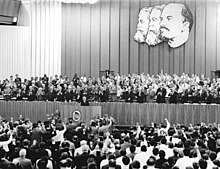Party congress of the SED


The SED party congress was officially the highest party organ of the SED . The Central Committee of the SED was determined at the party congress . The party congresses took place in East Berlin .
General
The party congresses of the SED were prepared and staged to a great extent by the party leadership . The delegates of the party congress were selected and invited by the Central Committee of the SED . Care was taken to ensure that the mass organizations had an appropriate number of members and that a proportion of women and young people as well as "exemplary workers" were selected. The candidates selected by the Central Committee were then ostensibly elected by the local party apparatus in delegates' conferences.
All contributions to the discussion at the party congress had to be submitted to the Central Committee for approval beforehand. Greetings from other mass organizations, in particular from the Thälmann pioneers and the youth association FDJ , the official “fight reserve of the party” , were part of the party congress direction. These younger speakers were allowed to loosen up the speeches, which often lasted for hours, with harmless joking remarks in their speeches. There was also a fighting address from comrades from the armed organs and international greetings from the fraternal socialist parties, whose chairmen or general secretaries were mostly represented by delegations in the presidium . In addition to the official part, there were long contributions to the discussion published in Neues Deutschland , as well as moderately critical discussions in the working groups during the party congress. On the occasion of the party congress, the comrades made “voluntary” contributions to over-fulfillment of the plan or particularly important party convention projects.
A special feature of every party congress was the non-stop writing down of the delegates, although all the official speeches on the next day were printed for pages in the party's central organ Neues Deutschland . Applause was precisely recorded in the wording, for example "long-lasting stormy applause, interrupted by cheers for the party and government of the GDR" . As a party convention gift, the delegates usually received a gold-plated watch that identified its wearer as an important person in the GDR.
In April 1946 an annual rotation of the party congresses was set at the founding party congress of the SED . The second party congress actually took place in 1947, but the third did not take place until 1950. Thereafter, the party congresses were held every four years (except between the fifth and sixth party congresses) and from 1971 every five years. The last regular party congress was the XI. Party Congress 1986. In the course of increasing economic difficulties, it was decided in 1989 that the XII. Party congress to be brought forward from 1991 to 1990 (15-19 May). As a result of the political change and peaceful revolution in the GDR in 1989, it no longer took place. Instead, there was a special SED party conference on December 8 and 9, 1989, where the SED acknowledged its new role and adopted the name SED / PDS.
The plenary sessions of the Central Committee took place between the party congresses . Their counting began anew after each party congress.
List of party conventions
| Period | Content | |
|---|---|---|
| I. Party Congress | April 21-22, 1946 | Founding party conference, union of KPD and SPD |
| II party congress | September 20-24, 1947 | |
| III. Party congress | July 20-24, 1950 | Introduction of a central committee , economic concentration on heavy industry , decision to build EKO Stahl , demolition of the Berlin Palace |
| IV. Congress | March 30 - April 6, 1954 | |
| V. Party Congress | July 10-16, 1958 | Postulate of the Ten Commandments of Socialist Morals and Ethics |
| VI. Party congress | January 15-21, 1963 | New economic system (NÖS) for planning and managing the national economy is decided. The plan was to decentralize the management and planning bodies and give companies more personal responsibility. |
| VII Party Congress | April 17-22, 1967 | |
| VIII Party Congress | June 15-19, 1971 | Era Secretary General Erich Honecker . One of the highlights on the opening day was the original greeting from the Salyut 1 crew to the party congress.
Unity of economic and social policy is decided. |
| IX. Party congress | May 18-22, 1976 | Adoption of a new program and statute |
| Xth Congress | April 11-16, 1981 | 2,700 delegates unanimously confirm the Central Committee and Erich Honecker as Secretary General. The Politburo will be reduced from 19 to 17 members. Adoption of an economic plan with the goal of a growth rate of 5 percent by 1985. |
| XI. Party congress | April 17-21, 1986 | The General Secretary of the CPSU Central Committee Mikhail Gorbachev speaks at the SED party congress. |
| SED / PDS special party conference | 8/9 and 16./17. December 1989 | After a controversial debate, proposals and counter-proposals on people and the mode of voting, the delegates approve the composition of the drafting committee, the application committee and the election committee of the SED party congress. Election of the new chairman of the SED, Gregor Gysi . The party is renamed the Socialist Unity Party of Germany - Party of Democratic Socialism . |
For the time after the renaming in 1989 see the list of party congresses of the PDS and the Left Party until 2007 .
Conference locations
- 1946–1947: Admiralspalast
- 1950–1971: Werner-Seelenbinder-Halle
- 1976–1986: Palace of the Republic
- 1989: Dynamo sports hall
Web links
Individual evidence
- ^ Marc Strassenburg: Archives of the SED and the FDGB - management bodies. Retrieved August 2, 2017 .
- ^ Name giver for submachine gun IX. Party congress



